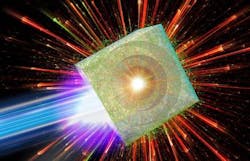Laser-driven microbubble implosion is new way to create a tabletop particle accelerator
Scientists at Osaka University (Osaka, Japan) have discovered a novel particle acceleration mechanism called microbubble implosion, in which extremely high-energy hydrogen ions (in other words, protons traveling at relativistic speeds) are emitted at the moment when ultrafast-laser-produced microbubbles in hydrides (hydrogen-contaning materials) shrink to atomic size.1
Led by Masakatsu Murakami, the group has reported an astonishing (simulated) physical phenomenon: when matter is compressed via the microbubble effect, creating densities comparable to matter the size of a sugar cube weighing more than 100 kg (a compression ratio higher than that for current inertial-confinement fusion experiments), high-energy protons are emitted from positively charged nanoscale clusters. Conventionally, an acceleration distance of several tens to hundreds of meters is necessary for conventional accelerators to generate such high proton energies.
In microbubble implosion, a phenomenon in which ions converge to a single point in space at half the speed of light plays a crucial role. This phenomenon, which looks like the opposite of the Big Bang, is essentially different from any previously discovered or proposed acceleration principles, including other laser tabletop acceleration techniques.
Attosecond time scale
A high-energy femtosecond laser (such as a petawatt laser) is used, with the focused beam producing a peak intensity of 1020 to 1022 W cm−2. The resulting "proton flash" occurs over a time interval of only on the order of 500 attoseconds and within a very small volume of a few cubic nanometers.
This new technique could produce physics and astronomy results too—for example, clarifying unknown space physics at large scales of time and space, such as the origins of high-energy protons (a type of cosmic ray). In addition, as a compact source of neutron radiation through nuclear fusion, this concept could be used in a variety of applications in medical treatment and industry in the future, such as proton radiotherapy to treat cancer and proton-driven inertial-confinement fusion.
Source: https://www.eurekalert.org/multimedia/pub/171111.php
REFERENCE:
1. M. Murakami, A. Arefiev, and M. A. Zosa, Nature Scientific Reports (2018); doi:10.1038/s41598-018-25594-3.

John Wallace | Senior Technical Editor (1998-2022)
John Wallace was with Laser Focus World for nearly 25 years, retiring in late June 2022. He obtained a bachelor's degree in mechanical engineering and physics at Rutgers University and a master's in optical engineering at the University of Rochester. Before becoming an editor, John worked as an engineer at RCA, Exxon, Eastman Kodak, and GCA Corporation.
